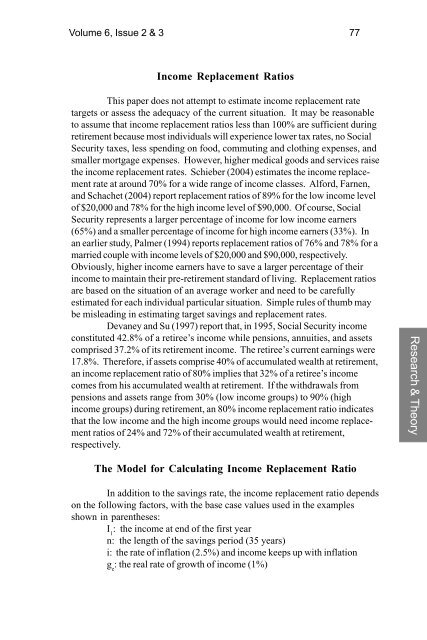3433-vol. 6 issue 2-3.pmd - iarfc
3433-vol. 6 issue 2-3.pmd - iarfc
3433-vol. 6 issue 2-3.pmd - iarfc
Create successful ePaper yourself
Turn your PDF publications into a flip-book with our unique Google optimized e-Paper software.
Volume 6, Issue 2 & 3 77<br />
Income Replacement Ratios<br />
This paper does not attempt to estimate income replacement rate<br />
targets or assess the adequacy of the current situation. It may be reasonable<br />
to assume that income replacement ratios less than 100% are sufficient during<br />
retirement because most individuals will experience lower tax rates, no Social<br />
Security taxes, less spending on food, commuting and clothing expenses, and<br />
smaller mortgage expenses. However, higher medical goods and services raise<br />
the income replacement rates. Schieber (2004) estimates the income replacement<br />
rate at around 70% for a wide range of income classes. Alford, Farnen,<br />
and Schachet (2004) report replacement ratios of 89% for the low income level<br />
of $20,000 and 78% for the high income level of $90,000. Of course, Social<br />
Security represents a larger percentage of income for low income earners<br />
(65%) and a smaller percentage of income for high income earners (33%). In<br />
an earlier study, Palmer (1994) reports replacement ratios of 76% and 78% for a<br />
married couple with income levels of $20,000 and $90,000, respectively.<br />
Obviously, higher income earners have to save a larger percentage of their<br />
income to maintain their pre-retirement standard of living. Replacement ratios<br />
are based on the situation of an average worker and need to be carefully<br />
estimated for each individual particular situation. Simple rules of thumb may<br />
be misleading in estimating target savings and replacement rates.<br />
Devaney and Su (1997) report that, in 1995, Social Security income<br />
constituted 42.8% of a retiree’s income while pensions, annuities, and assets<br />
comprised 37.2% of its retirement income. The retiree’s current earnings were<br />
17.8%. Therefore, if assets comprise 40% of accumulated wealth at retirement,<br />
an income replacement ratio of 80% implies that 32% of a retiree’s income<br />
comes from his accumulated wealth at retirement. If the withdrawals from<br />
pensions and assets range from 30% (low income groups) to 90% (high<br />
income groups) during retirement, an 80% income replacement ratio indicates<br />
that the low income and the high income groups would need income replacement<br />
ratios of 24% and 72% of their accumulated wealth at retirement,<br />
respectively.<br />
Research & Theory<br />
The Model for Calculating Income Replacement Ratio<br />
In addition to the savings rate, the income replacement ratio depends<br />
on the following factors, with the base case values used in the examples<br />
shown in parentheses:<br />
I 1<br />
: the income at end of the first year<br />
n: the length of the savings period (35 years)<br />
i: the rate of inflation (2.5%) and income keeps up with inflation<br />
g e<br />
: the real rate of growth of income (1%)
















